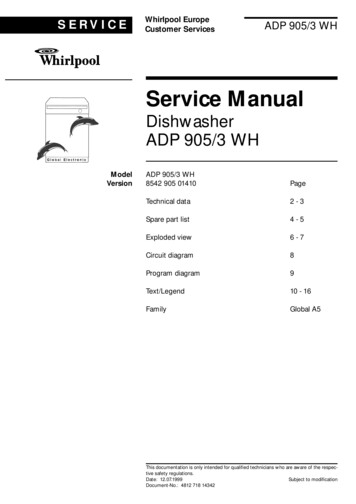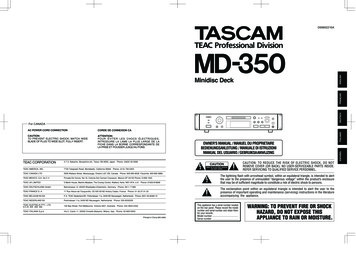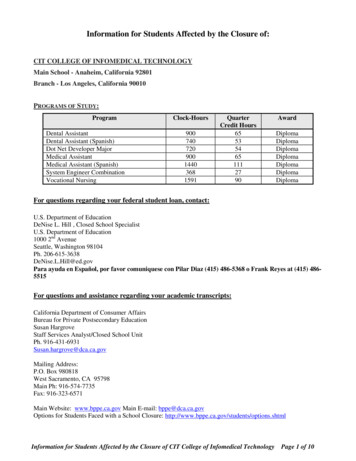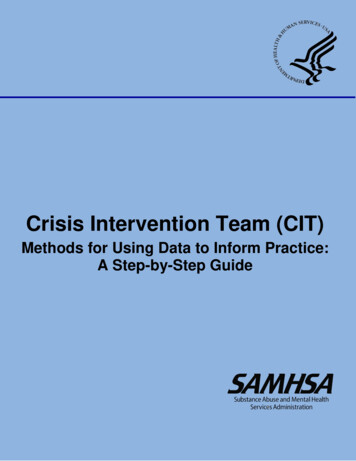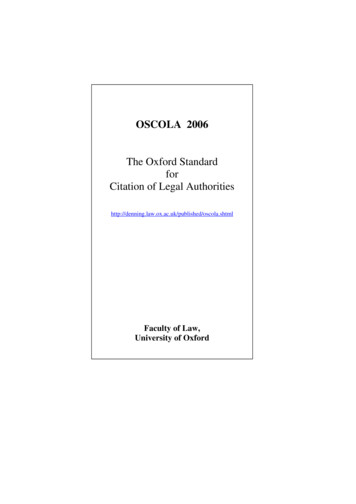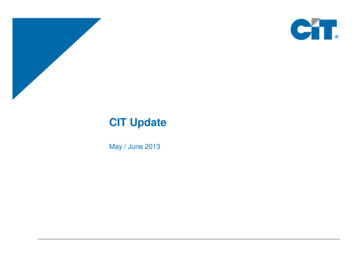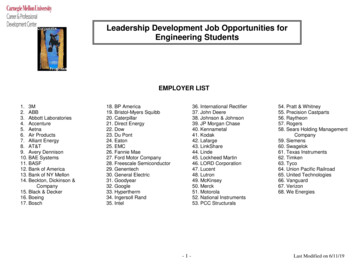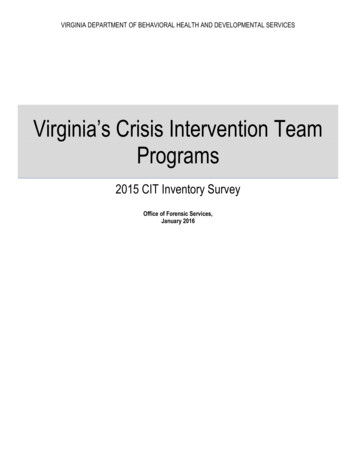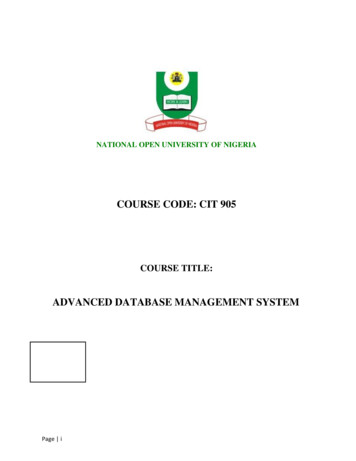
Transcription
CIT 905Advanced Database Management SystemNATIONAL OPEN UNIVERSITY OF NIGERIACOURSE CODE: CIT 905COURSE TITLE:ADVANCED DATABASE MANAGEMENT SYSTEMPage i
CIT 905Advanced Database Management SystemCOURSEGIUDEADVANCED DATABASE MANAGEMENT SYSTEMCourse TeamCourse CodeCourse TitleCIT 905Advanced Database Management SystemCourse Developer/WriterDr. Udoinyang G. InyangDepartment of Computer ScienceUniversity of UyoNigeriaContent EditorProf. Okonkwo Obikwelu RaphaelNnamdi Azikiwe University, AwkaCourse Material CoordinationDr. Vivian Nwaocha,Dr. Greg Onwodi &Dr. Francis B.OsangComputer Science DepartmentNational Open University of NigeriaPage ii
CIT 905Advanced Database Management SystemNATIONAL OPEN UNIVERSITY OF NIGERIACIT 905 :ADVANCED DATABASE MANAGEMENT SYSTEMNational Open University of NigeriaHeadquartersHeadquartersPlot 91, Cadastral Zone, Nnamdi Azikiwe Expressway, Jabi – Abuja,NigeriaLagos Office14/16 Ahmadu Bello WayVictoria IslandLagose-mail: centralinfo@nou.edu.ngURL: www.nou.edu.ngPage iii
CIT 905Published byNational Open University of NigeriaPrinted 2020ISBN: XXX-XXXPage ivAdvanced Database Management System
CIT 905Advanced Database Management SystemCONTENTS PAGEIntroduction . . vWhat you will Learn in this Course . vCourse Aims . vCourse Objectives . viWorking through this Course . . viCourse Materials . . viOnline Materials . . viStudy Units . . viiEquipment . . viiAssessment Page vviii
CIT 905Advanced Database Management SystemIntroductionThe course, Advanced Database Management System, is a 2 credit hour core course forstudents studying towards acquiring the Doctor of Philosophy (PhD) in in InformationTechnology. In this course we will study about the Database Management System as akey role in Information Management. Various principles of database managementsystem (DBMS) as well as its advanced features are discussed in this course. Thiscourse also considers distributed databases and emerging trends in database system.The overall aim of this course is to introduce you to various ways of designing andimplementing database systems, features and distributed databases. In structuring thiscourse, we commence with the basic design and implementation of relational databases.There are four modules in this course, each module consists of units of topics that youare expected to complete in 2 hours. The four modules and their units are listed below.What You Will Learn in this CourseThe overall aims and objectives of this course provide guidance on what you should beachieving in the course of your studies. Each unit also has its own unit objectives whichstate specifically what you should be achieving in the corresponding unit. To evaluateyour progress continuously, you are expected to refer to the overall course aims andobjectives as well as the corresponding unit objectives upon the completion of each.Course AimsThe overall aims and objectives of this course will help you to:1.Develop your knowledge and understanding of the underlying principles ofRelational Database Management System2.Build up your capacity to learn Database Management System advanced features3.Develop your competence in enhancing database models using distributeddatabases4.Build up your capacity to implement and maintain an efficient database systemusing emerging technologies and tools.Page vi
CIT 905Advanced Database Management SystemCourse ObjectivesUpon completion of the course, you should be able to:1. Describe the basic concepts of Relational Database Design2. Explain Database implementation and tools3. Describe SQL and Database System catalog.4. Describe the process of DB Query processing and evaluation.5. Discuss the concepts of transaction management.6. Explain the Database Security and Authorization.7. Describe the design of Distributed Databases.8. Know how to design a Database and XML.9. Describe the basic concept of Data warehousing and Data mining10. Discuss the emerging Database Models, Technologies and ApplicationsWorking through this CourseWe designed this course in a systematic way, so you need to work through it fromModule one, Unit One (1) through to Module four, Unit five (5). This will enable youappreciate the course better.Course MaterialsBasically, we made use of textbooks and online materials. You are expected to I, searchfor more literature and web references for further understanding. Each unit hasreferences and web references that were used to develop them.Online MaterialsFeel free to refer to the web sites provided for all the online reference materials requiredin this course. The website is designed to integrate with the print-based coursematerials. The structure follows the structure of the units and all the reading and activitynumbers are the same in both media.Study UnitsPage vii
CIT 905Advanced Database Management SystemCourse GuideModule 1: Database Design and ImplementalUnit 1: Concepts of Relational DatabaseUnit 2: Database Design and ImplementationUnit 3: Advance SQLUnit 4: Database System CatalogModule 2: DBMS Advance FeaturesUnit 1: Query Processing & EvaluationUnit 2: Transaction Management and RecoveryUnit 3: Database Security & AuthorizationModule 3: Distributed DatabasesUnit 1: Distributed database SystemUnit 2: Enhanced Database ModelsUnit 3: Object Oriented DatabaseUnit 4: Database and XMLUnit 5: Introduction to Data WarehousingUnit 6: Introduction to Data MiningModule 4: Emerging Trends and Example of DBMS ArchitectureUnit 1: Relational and Non-Relational databasesUnit 2: Conventional Database Management SystemsUnit 3: Emerging Database SystemsUnit 4. Database Services and Service ProvidersUnit 5: Modern Database ApplicationsModule one describes Database Design and Implementation.Module Two explains the DBMS advanced features.Module Three discusses the Distributed Database.Module Four discusses emerging trends in DBMS including technologies andapplications.Page viii
CIT 905Advanced Database Management SystemEquipmentIn order to get the most from this course, it is essential that you make use of a computersystem which has internet access.Recommended System Specifications:Processor2.5 GHZ Intel compatible processor4GB RAM500 GB hard drive with 5 GB free diskCD-RW drive.TCP/IP (installed)Operating SystemMicrosoft Windows 10Microsoft office 2007AntivirusMonitor*21-inch1024 X 768 Resolution16-bit high color*Non Standard resolutions (for example, some laptops) are not supported.DBMS ToolsORACLEPostgreSQLHardwareOpen Serial Port (for scanner)120W SpeakersHardware is constantly changing and improving, causing older technology to becomeobsolete. An investment in advanced and more efficient technology will more than payfor itself in improved performance results.If your system does not meet the recommended specifications, you may experienceconsiderably slower processing when working in the application. Systems that exceedthe recommended specifications will provide better handling of database files and fasterprocessing time, thereby significantly increasing your productivityPage ix
CIT 905Advanced Database Management SystemAssessmentThe course, Advanced Database Management Systems entails attending a two-hourfinal examination which contributes 50% to your final grading. The final examinationcovers materials from all parts of the course with a style similar to the Tutor- markedassignments.The examination aims at testing your ability to apply the knowledge you have learnedthroughout the course, rather than your ability to memorize the materials. In preparingfor the examination, it is essential that you receive the activities and Tutor-markedassignments you have completed in each unit. The other 50% will account for all theTMA‘s at the end of each unit.Tutor-Marked AssignmentAbout 20 hours of tutorials will be provided in support of this course. You will benotified of the dates, time and location for these tutorials, together with the name andphone number of your tutor as soon as you are allotted a tutorial group.Your tutor will mark and comment on your assignments, keep a close watch on yourprogress and on any difficulties you might encounter and provide assistance to youduring the course. You must mail your TMAs to your tutor well before the due date (atleast two working days are required). They will be marked by your tutor and returned toyou as soon as possible.Do not hesitate to contact your tutor by phone, e-mail if you need help. The followingmight be circumstances in which you would find help necessary. You can also contactyour tutor if:1.you do not understand any part of the study units or the assigned readings2.you have difficulty with the TMAs3. you have a question or problem with your tutor‘s comments on an assignment or4.with the grading of an assignmentPage x
CIT 905Advanced Database Management SystemYou should try your best to attend tutorials, since it is the only opportunity to have aninteraction with your tutor and to ask questions which are answered instantly. You canraise any problem encountered in the course of your study. To gain maximum benefitfrom the course tutorials, you are advised to prepare a list of questions before attendingthe tutorial. You will learn a lot from participating in discussions actively.Course OverviewThis section proposes the number of weeks that you are expected to spend on the fourmodules comprising of 30 units and the assignments that follow each of the unit. Werecommend that each unit with its associated TMA is completed in one week, bringingyour study period to a maximum of 30 weeks.How to Get the Most from this CourseIn order for you to learn various concepts in this course, it is essential to practice.Independent activities and case activities which are based on a particular scenario arepresented in the units. The activities include open questions to promote discussion onthe relevant topics, questions with standard answers and program demonstrations on theconcepts. You may try to delve into each unit adopting the following steps:i.Read the study unitii. Read the textbook, printed or online referencesiii. Perform the activitiesiv. Participate in group discussionsv.Complete the tutor-marked assignmentsvi. Participate in online discussionsThis course makes intensive use of materials on the world-wide web Specific webaddress will be given for your reference. There are also optional readings in the units.You may wish to read these to extend your knowledge beyond the required materials.They will not be assessed.Summary:Page xi
CIT 905Advanced Database Management SystemThe course, Advanced Database Management Systems is intended to develop yourunderstanding of the basic concepts of database systems, thus enabling you acquireskills in designing and implementing Database Management Systems. This course alsoprovides you with practical knowledge and hands-on experience in implementing andmaintaining a system. We hope that you will find the course enlightening and that youwill find it both interesting and useful. In the longer term, we hope you will getacquainted with the National Open University of Nigeria and we wish you everysuccess in your futurePage xii
CIT 905Advanced Database Management SystemMAINCOURSEADVANCED DATABASE MANAGEMENT SYSTEMCourse Developer:Dr. Udoinyang G. InyangDepartment of Computer ScienceUniversity of UyoUyo, NigeriaCourse Writer :Dr. Udoinyang G. InyangDepartment of Computer ScienceUniversity of UyoUyo, NigeriaProgramme Leader :National Open University of NigeriaCourse Coordinator :National Open University of NigeriaPage xiii
CIT 905Advanced Database Management SystemNATIONAL OPEN UNIVERSITY OF NIGERIACIT 905 :ADVANCED DATABASE MANAGEMENT SYSTEMNational Open University of NigeriaHeadquartersNo. 5 Dares Salaam StreetOff Aminu Kano CrescentWuse II, AbujaNigeriae-mail: centralinfo@nou.edu.ngURL: www.nou.edu.ngLagos Office:14/16 Ahmadu Bello WayVictoria IslandLagosPublished byNational Open University of NigeriaPrinted 2020ISBN: XXX-XXXPage xiv
CIT 905Advanced Database Management SystemCONTENTS PAGEMODULE 1: Database Design and ImplementalUnit 1: Relational Database Design and Implementation1. Introduction1.1Objectives1.2 What is a data model?1111. What Is Relational Database?11.4 Database Schema41.5 Database Schema Integration51.6 Database Design111.5 The Entity Relationship Diagram (ERD)151.6 Conclusion271.7 Tutor-Marked Assignment271.8 References and Further Readings27Unit 2: Advance SQL2.1 Introduction292.1. Objectives292.229Basics Concepts of SQL2.3. History of SQL312.432The Form of a basic SQL Query2.5. SQL Statements332.5.1 Data Manipulation Language (DML)332.6Viewing the Structure of a Table352.7SQL SELECT Statements362.7.1 Using SQL for Web Site372.837SQL SYNTAX2.8.1 The SQL SELECT Statement402.948INSERT statementPage xv
CIT 905Advanced Database Management System2.10 UPDATE statement492.11 Joining tables502.12 Arithmetic Operations512.13 Operator Precedence522.15 Conclusion582.16 Tutor marked Assignment582.17 References and Further Reading59Unit 3: Database System Catalog3.0Introduction604.1Objectives:603.2What is a database system catalog?603.3Functions of Data Dictionary633.3.2 Views with the Prefix d Assignment (TMA)673.9References and Further Readings68Module 2: DBMS Advance FeaturesUnit 1: Query Processing & Evaluation2.1.0 Introduction692.1.2 Objectives692.1.3 Query Processing692.1.4 Catalog Information for Cost Estimation722.1.5 Measures of Query Cost732.1.5 Selection Operation752.1.5 Index scan772.1.5 Join Operation78Page xvi
CIT 905Advanced Database Management System2.1.5 Query Optimization892.1.5Dynamic Programming902.1.5Structure of Query Optimizer942.1.5Conclusion952.1.5Tutor Marked Assignment952.1.7.References and Further Readings96Unit 2: Transaction Management and Recovery2.2.0. Introduction972.2.1. What is a Transaction?972.2.1. Properties of Transaction972.2.2 Transaction States1022.2.3 Transactions and Schedules1052.2.4 Concurrent Execution of Transactions1052.2.5 Concurrency control for database management1122.2.6 Locking Techniques for Concurrency Control Basedon Time Stamp Ordering1992.2.7 Database Recovery Management1242.2.8 Introduction to ARIES1262.2.9 Media Recovery1372.2.10 Self-Assessment Exercises1412.2.11 Tutor Marked Assignment1412.2.12 References/Suggested Readings141Unit 3: Database Security & Authorization2.3.0 Introduction2.3.1 Objectives2.3.2 Database Security and Authorization: Basic Concepts2.3.4 Types of Security Breaches in a Database System1. Security threats to DatabasePage xvii142142143144
CIT 905Advanced Database Management System2.3.6 Counter Measures1462.3.7 Conclusion1542.3.8 Tutor Marked Assignment1542.3.8 References and Further Reading154Module 3: Distributed DatabasesUnit 1: Distributed database System3.1Introduction1563.1.1 Objectives1563.1.2 What is Distributed Database System1563.1.3 Types of Distributed Database Systems1583.1.4 Advantages and Disadvantages of Distributed Databases1591. Components of Distributed Database Systems1613.1.7 Current Trends in Distributed Databases1613.1.5 Conclusion1633.1.6. Summary1632. Tutor Marked Assignment3. Further Reading and other Resources164164Unit 2: Enhanced Database Models3.2.1 Introduction1653.2.1 Concepts of Network Data Modeling1653.2.1 Records, Record Types, and Data Items1663.2.2 Stored Representations of Set Instances1703.2.2 Using Sets to Represent M:N Relationships1723.2.3 Constraints in the Network Model1753.2.4 Basic Concepts for Network Database Manipulation1793.2.5 Hierarchical Model1803.2.6 Conclusion1843.2.7 Tutor Marked Assignment1853.2.8 References/Suggested Readings185Page xviii
CIT 905Advanced Database Management SystemUnit 3: Object Oriented Database3.3.0 Introduction1863.3.1 Objectives1871. Basic concepts of OO Programming1883.3.3 Why Object Oriented Databases?1913.3.5 Object Oriented Databases Models2083.3.6 Conclusion2143.3.7 Tutor marked Assignment2143.3.8 References/ Further Readings214Unit 4: Database and XML3.4.1 Introduction2163.4.2 Objectives2163.4.3 What is XML?2161.XML elements2.Self-Assessment Questions2303. Summary3.4.7. Conclusion2303.4.8 Tutor Marked Assignment2303.4.9 References and Further Reading230Unit 5: Introduction to Data Warehousing3.5.0 Introduction2323.5.1 Objectives2323.5.1.12333.5.2What is Data Warehouse?Components of a Data Warehouse2353.5.3 Warehouse Schemas2373.5.4 Conclusion2383.5.5 Tutor Marked Assignment2393.5.6 References and Further ReadingsPage xix239
CIT 905Advanced Database Management SystemUnit 6: Introduction to Data Mining3.6.1 Introduction2403.6.2 Objectives2413.6.3 What is datamining?2413.6.3.1 Sources of data for KDDD and DM2413.6.4 KDD Stages2443.6.5 Mining Systems2453.6.6 Types of mined data2463.6.7. DM Tasks and Techniques2483.6.8 Conclusion2503.6.9 Tutor Marked Assignment2503.6.10 References and Further Reading250Module 4: Emerging Trends and Example of DBMS ArchitectureUnit 1: Relational and Non-Relational databases1. Introduction2511.Objectives:2512.SQL-based Database Management Systems2522.1Advantages of RDBMS:2532.2Disadvantages of RDBMS:2533.0Non-Relational Database Systems (NoSQL-based)2533.1Advantages of Non-relational database systems2543.2Disadvantages of Non-Relational database systems:2543.3 Types of NoSQL Database engines2554.0Conclusion:2575.0References and Further Reading257Unit 2: Conventional Database Management Systems1.Introduction1.1 ObjectivesPage xx258258
CIT 905Advanced Database Management System2.0 Oracle Database Management System2582.1Programming Language Support by Oracle:2582.2Multi – Model Persistence:2601.261GraalVM and the Oracle Database:5.1MySQL2645.2Features of MySQL Database:2645.3MySQL User interfaces2675.3.2Advantages of using MySQL2705.3.3Disadvantages of using MySQL2716.0Microsoft SQL2716.1Microsoft SQL .5 Further Reading and References:284UNIT 3: Emerging Database Systems4.3.0Introduction2864.3.2Emerging Database Technologies2864.3.2.1Internet Databases2864.3.3Digital Libraries2884.3.4Multimedia databases2944.3.5Mobile Databases2964.3.6Spatial Databases2994.3.7Emerging databases in support of scientific data3054.3.7.1Vertical 104.6Tutor Marked Assignment310Page xxi
CIT 905Advanced Database Management System4.7Further Readings/Reference311Unit 4. Database Services and Service .1Database as a Service (DBaas)3134.4.3Developer agility3164.4.3.2IT 23Software2.Oracle Stream Analytics3274.4.2.4Data Platform3294.4.2.4Gold Data Using ORACLE 12c3294.4.3.1Oracle NoSQL Database3304.4.5Non-native Database Management Systems3334.4.4Conclusion3364.4.5Tutor Marked Assignment3374.4.6References and Further Readings337Unit 5: Modern Database Applications4.5.1 Introduction3384.5.1.2339Objectives4.5.3 Classical SQL and its limitations3394.5.2. Queries based on Fuzzy Logic3411. On-line Analytical Processing Databases (OLAP)4.5.6 Overview of OLAP Systems2. Conclusion2.343343350Tutor Marked Assignment3513.351Page xxiiFurther Readings/References
CIT 905Advanced Database Management SystemBlank PagePage xxiii
CIT 905Advanced Database Management SystemMODULE 1: DATABASE DESIGN AND IMPLEMENTATIONUNIT 1: RELATIONAL DATABASE DESIGN AND IMPLEMENTATION1.INTRODUCTIONThis unit discusses the relational data model. Which uses the concept of mathematicalrelation, which looks somewhat like a table of values, as its basic building blocks, andhas its theoretical basics in set theory and first order predicate logic. In this unit, wewill discuss the basic characteristics for the relational model and its normalizationprocesses. The model has been implemented in a large number of commercial systemsover the last years.1.1 OBJECTIVES.The objectives of this unit include to:1.Describe the data model and its concepts.2.discuss the relational database model.3. Help the students understand the concepts of normalization in databasedesign1.2 What is a data model?A data model is a collection of conceptual tools for describing data, datarelationships, data semantics, and consistency constraints. In this part, we focus on therelational model. It is a notation for describing data or information. The descriptiongenerally consists of three parts: Structure of the data, Operations on the data andConstraints on the data. In unit we describe the relational database model1.3What Is Relational Database?A relational database is based on the relational model and uses a collection oftables to represent both data and the relationships among those data. It also includes aData Manipulation Language (DML) and Data Definition Language (DDL). Therelational model is today the primary data model for commercial data processingapplications - especially for storing financial records, manufacturing and logisticalPage 1
CIT 905Advanced Database Management Systeminformation, personnel data and much more. It attained its primary position because of itssimplicity, which eases the job of the programmer, compared to earlier data models suchas the network model or the hierarchical model.1.2.1 Structure of Relational DatabasesA relational database consists of a collection of tables, each of which is assigned aunique name. For example, consider the Facilitator table (Table 2.1), which storesinformation about facilitators. The table has four columns: ID, name, department andrank. Each row of this table records information about a facilitator, consisting of thefacilitator‘s ID, name, department, and rank. Similarly, the course table (Table 2.2)stores information about courses, consisting of a course code, title, department, andCredit Hour(CH), for each course. Note that each instructor is identified by the value ofthe column ID, while each course is identified by the value of the column course code.IDTable 2.1: Facilitator tableNameDepartment001010PatienceComputer odwinPhysicsLecturer yReaderTable 2.2: Facilitator tableTitleDepartmentCourseCodePage 2RankCHCIT 751PatienceComputer Science3CHM 222InyangChemistry4PHY 234GodwinPhysics3HIS 442DanielHistory2GPY 130SulemanGeography4
CIT 905Advanced Database Management SystemIn general, a row in a table represents a relationship among a set of values. Since a tableis a collection of such relationships, there is a close correspondence between the conceptof table and the mathematical concept of relation, from which the relational data modeltakes its name. In mathematical terminology, a tuple is simply a sequence (or list) ofvalues. A relationship between n values is represented mathematically by an n-tuple ofvalues, i.e., a tuple with n values, which corresponds to a row in a table.Thus, in the relational model the term relation is used to refer to a table, whileterm tuple is used to refer to a row. Similarly, the term attribute refers to a columnheader of a table while the data type describing the types of values that can appear ineach column is called a domain. Examining Table 2.1, we can see that the relationinstructor has four attributes: ID, name, department, and rank. We use the term relationinstance to refer to a specific instance of a relation that is, containing a specific set ofrows. The instance of a facilitator shown in Table 2.1 has 5 tuples, corresponding tofive facilitators.Each attribute of a relation, has a set of permitted values, called the domain ofthat attribute. Thus, the domain of the rank attribute of relation is the set of all possibleranks values, while the domain of the name attribute is the set of all possiblefacilitators’ names. A domain is atomic if elements of the domain are considered to beindivisible units. For example, suppose the table facilitator had an attribute phonenumber, which can store a set of phone numbers associated to the facilitator. Then thedomain of phone number would not be atomic, since an element of the domain is a setof phone numbers (may be more than one phone numbers), and it has subparts, namelyeach individual phone numbers in the set.The important issue is not what the domain itself is, but rather how we usedomain elements in our database. Suppose now that the phone number attribute stores asingle phone number. Even then, if we split the value from the phone number attribute(for example 234-873-424-1626), into a country code, network provider, an area codeand a local number, then it is considered as a non-atomic value. If view each phonenumber as a single indivisible unit, then the attribute phone number would then have anatomic domain.Page 3
CIT 905Advanced Database Management System1.2.2 Database SchemaA database schema, is the logical design of the database, and the databaseinstance, is a snapshot of the data in the database at a given instant in time. A databaseschema represents the logical configuration of all or part of a relational database. It canexist both as a visual representation and as a set of formulas (known as integrityconstraints), that govern a database. These formulas are expressed in a DDL, such asSQL. As part of a data dictionary, a database schema indicates how the entities thatmake up the database relate to one another, including tables, views, stored procedures,and more. At the most basic level, a database schema indicates which tables or relationsmake up the database, as well as the attributes included on each table. Thus, theterms schema diagram and entity-relationship diagram are often interchangeable. Theconcept of a relation corresponds to the programming-language notion of a variable,while the concept of a relation schema corresponds to the programming-languagenotion of type definition.A database designer creates a database schema mainly to help programmers whosesoftware will interact with the database. The process of creating a database schema iscalled data modeling. There are two main kinds of database schema:1.A logical database schema conveys the logical constraints that apply to the storeddata. It may define integrity constraints, views, and tables.2.A physical database schema lays out how data is stored physically on a storagesystem in terms of files and indices.1.2.3 What is Database instance or database schema?These terms, though related, do not mean the same thing. A database schema is a sketchof a planned database. It does not actually have any data in it. A database instance, onthe other hand, is a snapshot of a database as it existed at a particular time. Thus,database instances can change over time, whereas a database schema is usually static,since it is arduous task to change the structure of a database once it is operational.Database schemas and database instances can affect one another through a databasePage 4
CIT 905Advanced Database Management Systemmanagement system (DBMS). The DBMS makes sure that every database instancecomplies with the constraints imposed by the database designers in the databaseschema.1.2.3Database Schema IntegrationSchema integration describes the task of building a global data schema from a set oflocal schemas (usually with overlapping semantics) to provide the user with a unifiedview of the entire dataset. Schema integration is defined as the process of mergingseveral conceptual schemas into a global conceptual schema that represents all therequirements of the application. Schema integration is used to merge two or moredatabase schemas into a single schema that can store data from both the originaldatabases.The goal is to give the user of the global schema an illusion of a single dataset specifiedby a single schema.1.Schema integration is used when two or more existing databases must becombined, for example, when a new management information system is beingdeveloped.2.Schema integration may be used when the process of database design is too large tobe carried out by one individual. Two or more designers will build models ofdifferent parts of the database and use schema integration to merge the resultingmodels.There are two major types of schema integration:1.View Integration: View integration takes place during the design of a newdatabase when user requirements may be different for each user group. Viewintegration is used to merge different viewpoints into a single data model.2.Database Integration: Database integration is used when two or more databasesmust be combined to produce a single schema, called a global schema.Reasons for Schema IntegrationPage 5
CIT 9051.Advanced Database Management SystemThe structure of the database for large applications is too complex to be modeled bya single designer in a single view.2.User groups typically operate independently in organization and have their ownrequirements and expectations of data, which may conflict with other user groups3.When two database schemas are designed by different designers using different userrequirements, the resulting schemas will often present contrasting views of the samedata.Figure 2.1: Two schemas designed differentlyFor example above, the relationship between employee and project in one database isrepresented as a relationship between employee, department and project in anotherdatabase.Figure 2.2: entity relationship in two databasesThis situation might occur in an organization that allows different departments to havedifferent rules as to how employees are allocated to projects. For example, in onedepartment employees may be assigned to projects while in another departmentemployees may not be considered to be directly related to a project.
NATIONAL OPEN UNIVERSITY OF NIGERIA CIT 905 : ADVANCED DATABASE MANAGEMENT SYSTEM National Open University of Nigeria Headquarters Headquarters Plot 91, Cadastral Zone, Nnamdi Azikiwe Expressway, Jabi - Abuja, Nigeria Lagos Office 14/16 Ahmadu Bello Way Victoria Island Lagos e-mail: centralinfo@nou.edu.ng URL: www.nou.edu.ng
